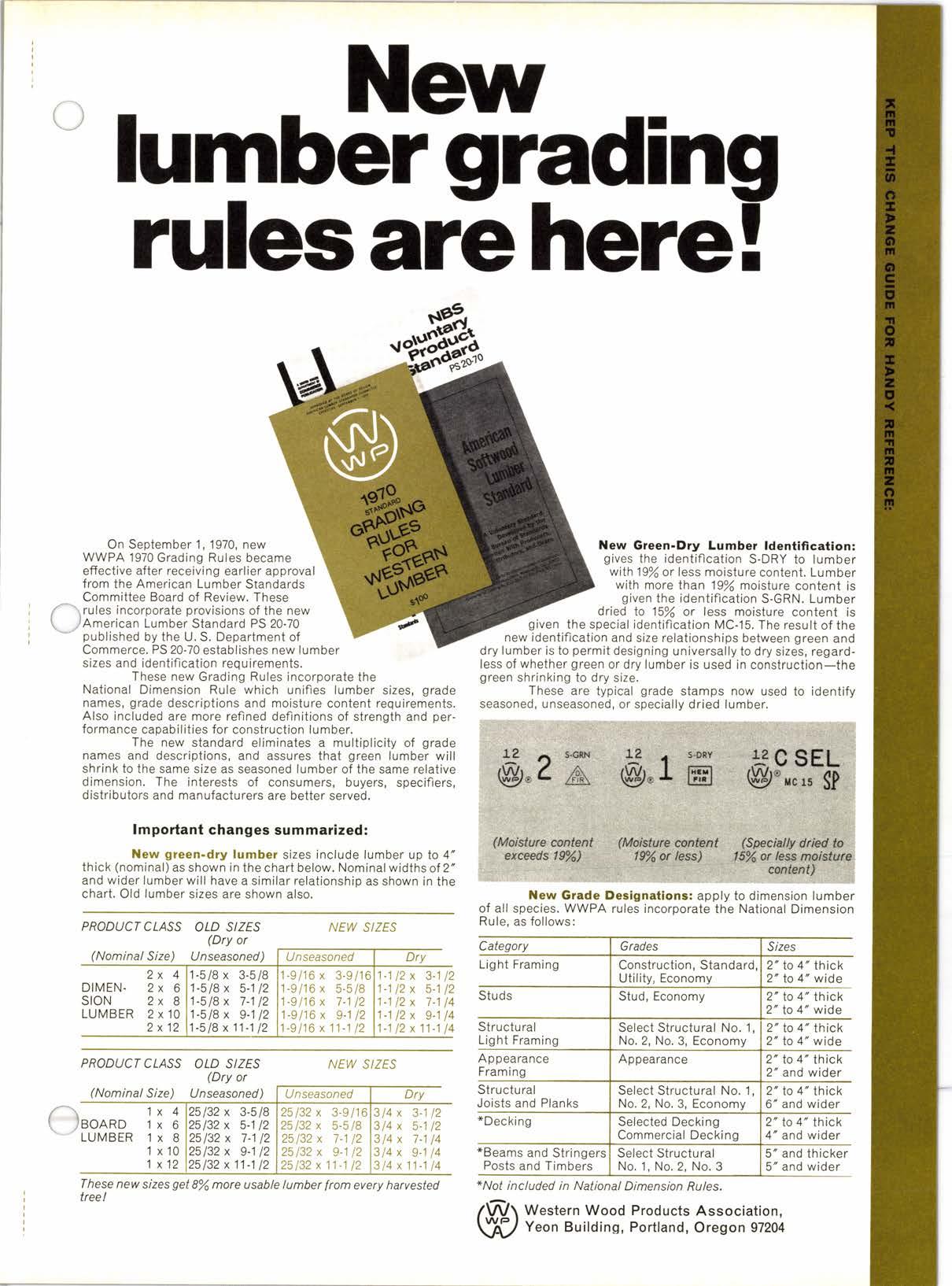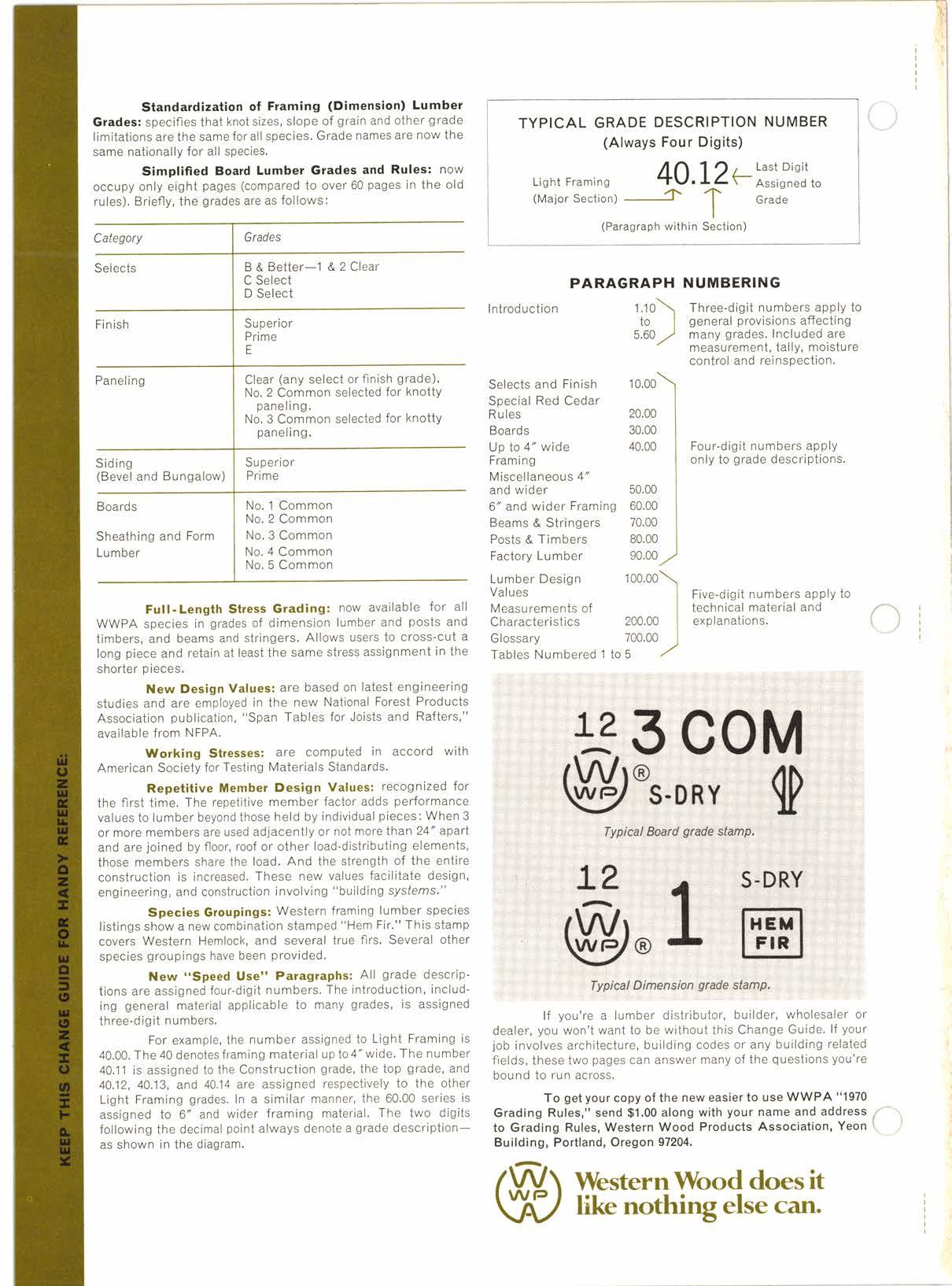
3 minute read
New lumbergrading rulesarehereJ
**31 ffiJ"#Lll,l' A?13;1"1'". I
effective after receiving earlier approval ! from the American Lumber Standards I Committee Board of Review. These \ f\,,rules incorporate provisions of the new \ ,iAmerican Lumber Standard PS 20-70 published by the U. S. Department of Commerce, PS 20-70 establishes new lumber sizes and identification requirements,
These new Grading Rules incorporate the National Dimension Rule which unifies lumber sizes, grade names, grade descriptions and moisture content requirements. Also included are more refined definitions of strength and performance capabilities for construction lumber.
The new standard eliminates a multiplicity of grade names and descriptions, and assures that green lumber will shrink to the same size as seasoned lumber of the same relative dimension. The interests oJ consumers, buyers, specifiers, distributors and manuJacturers are better served, lmportant changes summarized: more usable lumber from every harvested tree
New green-dry lumber sizes include lumber up to 4" thick (nominal) as shown in the chart below. Nominal widths of 2' and wider lumber will have a similar relationshio as shown in the chart. Old lumber sizes are shown also.
New Green-Dry Lumber ldentification: gives the identification S-DRY to lumber with 19% or less moisture content. Lumber with more than 'l9ol moisture content is given the identiflcation S-GRN. Lumber dried to 15% or less moisture content is given the special identification MC-15. The result of the new identification and size relationships between green and dry lumber is to permit designing universally to dry sizes, regardless of whether green or dry lumber is used in construction-the green shrinking to dry size ' These are typical 'grade stamps now used to identify seasoned, unseasoned, or specially dried lumber.
New Grade Designations: apply to dimension lumber of all species. WWPA rules incorporate the National Dimension Rule, as follows:
Standardization of Framing (Dimension) Lumber
Grades: specifies that knot sizes, slope of grain and other grade limitations are the same for all species. Grade names are now the same nationally for all species.
Simplified Board Lumber Grades and Rules: now occupy only eight pages (compared to over 60 pages in the old rules). Briefly, the grades are as follows: Category Grades Selects B&Better-1 &2Clear
TYPICAL GRADE DESCRIPTION NUMBER (Always Four Digits)
40.IztsfiH'::',"
I ntrod uction
Paneling Clear (any select or finish grade). No. 2 Common selected for knottY pane I i ng. No. 3 Common selected for knottY panel ng.
Boards
Sheathing and Form Lumber
No.1 Common No.2 Common No. 3 Common No. 4 Common No, 5 Common
Full-Length Stress Grading: now available for all WWPA species in grades of dimension lumber and posts and timbers, and beams and stringers. Allows users to cross-cut a long piece and retain at least the same stress assignment in the shorter pieces.
New Design Values: are based on iatest engineering studies and are employed in the new National Forest Products Association publication, "Span Tables for Joists and Rafters," available from NFPA.
Working Stresses: are computed in accord with American Society for Testing Materials Standards.
Repetitive Member Design Values: recognized for the flrst time. The repetitive member factor adds performance values to lumber beyond those held by individual pieces: When 3 or more members are used adjacently or not more than 24" apart and are joined by floor, roof or other load'distributing elements, those members share the load. And the strength of the entire construction is increased. These new values facilitate design, engineering, and construction involving "building sysfems."
Species Groupings: Western framing lumber species Iistings show a new combination stamped "Hem Fir." This stamp covers Western Hemlock, and several true flrs. Several other species groupings have been provided.
New "Speed Use" Paragraphs: All grade descriptions are assigned four-digit numbers. The introduction, including general material applicable to many grades, is assigned three-digit numbers.
For example, the number assigned to Light Framing is 40.00, The 40 denotes f raming material up to 4" wide. The number 40.11 is assigned to the Construction grade, the top grade, and 40.12, 40.13, and 40,14 are assigned respectively to the other Light Framing grades. ln a similar manner, the 60.00 series is assigned to 6" and wider framing material. The two digits following the decimal point always denote a grade descriptionas shown in the diagram.
Paragraph Numbering
Selects and Finish
Special Red Cedar
Ru les
Boards
Up to 4" wide
Framing
Miscellaneous 4" and wider
6" and wider Framing
Beams & Stringers
Posts & Timbers
Fantnrv I rrmhor
Lumber Design
Val ues
Measu rements of Characteristics
G lossary Tables Numbered 1
1.10\ tol
5.60 2
I Grade I (Paragraph within Section) *3COM
Three-digit numbers apply to general provisions affecting many grades. Included are measurement, tally, moisture control and reinspection.
Four-digit numbers apply only to grade descriptions,
Five-digit numbers apply to technical material and exp lanations.
Typical Dimension grade stamP' lf you're a lumber distributor, builder, wholesaler or dealer, you won't want to be without this Change Guide. lf your job involves architecture, building codes or any building related flelds, these two pages can answer many of the questions you're bound to run across.
To get your copy of the new easier to use WWPA "1970 Grading Rules," send $1.00 along with your name and address, to Grading Rules, Western Wood Products Association, Yeon t Building, Portland, Oregon 97204.











